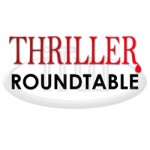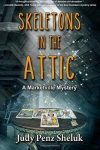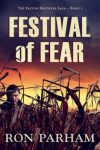

September 26 – October 2: “Can there be too many surprises in a thriller plot?”
 Can there be too many surprises in a thriller plot? Must each thrill help move the plot? These are the questions posed to this week’s ITW Members Paul McGoran, Arlene Kay, Judy Penz Sheluk, Ron Parham, Wendy Walker and Maynard Sims. You won’t want to miss it!
Can there be too many surprises in a thriller plot? Must each thrill help move the plot? These are the questions posed to this week’s ITW Members Paul McGoran, Arlene Kay, Judy Penz Sheluk, Ron Parham, Wendy Walker and Maynard Sims. You won’t want to miss it!
~~~~~
 Judy Penz Sheluk’s debut mystery novel, The Hanged Man’s Noose, the first in the Glass Dolphin Mystery series, was published in July 2015 by Barking Rain Press. Skeletons in the Attic, Judy’s second novel, and the first in her Marketville Mystery series, will be published in August 2016 by Imajin Books. Judy’s short crime fiction appears in World Enough and Crime (Carrick Publishing), The Whole She-Bang 2 (Toronto Sisters in Crime), Flash and Bang (Untreed Reads) and Live Free or Tri: a collection of three short mystery stories. She is also the author of Unhappy Endings: a collection of three flash fiction stories. In her less mysterious pursuits, Judy works as a freelance writer; her articles have appeared regularly in dozens of U.S. and Canadian consumer and trade publications. In addition to ITW, Judy is also a member of Sisters in Crime International, Sisters in Crime – Guppies, Sisters in Crime – Toronto, Crime Writers of Canada, and the Short Mystery Fiction Society. She lives in Alliston, Ontario, Canada, with her husband, Mike, and their golden retriever, Leroy Jethro “Gibbs”.
Judy Penz Sheluk’s debut mystery novel, The Hanged Man’s Noose, the first in the Glass Dolphin Mystery series, was published in July 2015 by Barking Rain Press. Skeletons in the Attic, Judy’s second novel, and the first in her Marketville Mystery series, will be published in August 2016 by Imajin Books. Judy’s short crime fiction appears in World Enough and Crime (Carrick Publishing), The Whole She-Bang 2 (Toronto Sisters in Crime), Flash and Bang (Untreed Reads) and Live Free or Tri: a collection of three short mystery stories. She is also the author of Unhappy Endings: a collection of three flash fiction stories. In her less mysterious pursuits, Judy works as a freelance writer; her articles have appeared regularly in dozens of U.S. and Canadian consumer and trade publications. In addition to ITW, Judy is also a member of Sisters in Crime International, Sisters in Crime – Guppies, Sisters in Crime – Toronto, Crime Writers of Canada, and the Short Mystery Fiction Society. She lives in Alliston, Ontario, Canada, with her husband, Mike, and their golden retriever, Leroy Jethro “Gibbs”.
 Wendy Walker is a family law attorney in Connecticut. Prior to her legal career, she worked as a financial analyst at Goldman, Sachs. All Is Not Forgotten is her first psychological thriller. Wendy is currently writing her second thriller and managing a busy household of teenage boys.
Wendy Walker is a family law attorney in Connecticut. Prior to her legal career, she worked as a financial analyst at Goldman, Sachs. All Is Not Forgotten is her first psychological thriller. Wendy is currently writing her second thriller and managing a busy household of teenage boys.
 Before turning to crime fiction, Paul McGoran had a varied career as Navy linguist, marketing executive, management consultant and day trader. His first published novel was the pulp thriller, Made for Murder (New Pulp Press, 2015). He is also the author of a collection of short noir fiction, Paying for Pain. Paul writes fiction because it is most immersive activity he has ever known. His next novel will bring his P.I. protagonist back to his old hometown to solve the revenge murder of the bully who terrorized his childhood.
Before turning to crime fiction, Paul McGoran had a varied career as Navy linguist, marketing executive, management consultant and day trader. His first published novel was the pulp thriller, Made for Murder (New Pulp Press, 2015). He is also the author of a collection of short noir fiction, Paying for Pain. Paul writes fiction because it is most immersive activity he has ever known. His next novel will bring his P.I. protagonist back to his old hometown to solve the revenge murder of the bully who terrorized his childhood.
 Ron Parham is an accomplished and award-winning author of thrillers Molly’s Moon and Copperhead Cove, and the upcoming Festival of Fear, due out in the summer of 2016. His novels are about ordinary people caught up in extraordinary circumstances. Festival of Fear takes place in southwest Iowa, where he grew up and spent his childhood. All three novels are part of the Paxton Brothers Saga. He now lives and writes in the Temecula Valley, a world-famous wine-growing region just east of Los Angeles and north of San Diego. He is currently working on his first novel of the Gas Lamp Saga, starring Jake Delgado, the private investigator from his first two novels.
Ron Parham is an accomplished and award-winning author of thrillers Molly’s Moon and Copperhead Cove, and the upcoming Festival of Fear, due out in the summer of 2016. His novels are about ordinary people caught up in extraordinary circumstances. Festival of Fear takes place in southwest Iowa, where he grew up and spent his childhood. All three novels are part of the Paxton Brothers Saga. He now lives and writes in the Temecula Valley, a world-famous wine-growing region just east of Los Angeles and north of San Diego. He is currently working on his first novel of the Gas Lamp Saga, starring Jake Delgado, the private investigator from his first two novels.
 Arlene Kay spent twenty years as a Senior Executive with the Federal Government where she was known as a most unconventional public servant. Experience in offices around the nation allowed her to observe both human and corporate foibles and rejoice in unintentional humor.
Arlene Kay spent twenty years as a Senior Executive with the Federal Government where she was known as a most unconventional public servant. Experience in offices around the nation allowed her to observe both human and corporate foibles and rejoice in unintentional humor.
 Maynard Sims are the joint authors of numerous novels, including the Jack Callum series, the Bahamas series, the Department 18 series, and many standalones. They have ten collections of stories, several novellas, as well as over thirty edited works.
Maynard Sims are the joint authors of numerous novels, including the Jack Callum series, the Bahamas series, the Department 18 series, and many standalones. They have ten collections of stories, several novellas, as well as over thirty edited works.
- LAST GIRL MISSING with K.L. Murphy - July 25, 2024
- CHILD OF DUST with Yigal Zur - July 25, 2024
- THE RAVENWOOD CONSPIRACY with Michael Siverling - July 19, 2024
